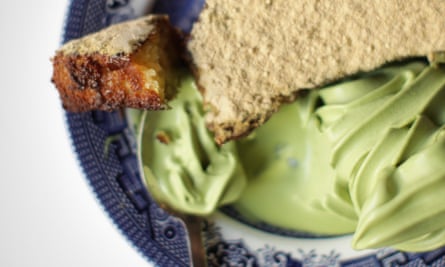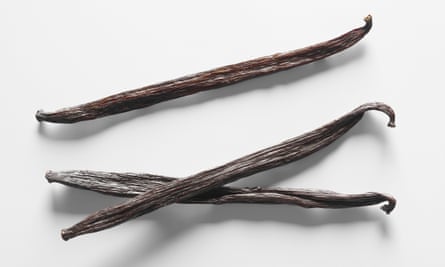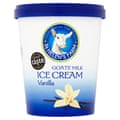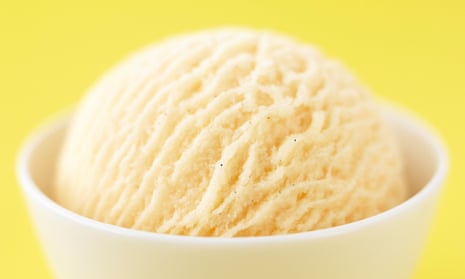Plain. Conventional. Unimaginative. That’s vanilla.
The Guardian’s product and service reviews are independent and are in no way influenced by any advertiser or commercial initiative. We will earn a commission from the retailer if you buy something through an affiliate link. Learn more.
Or rather, that’s vanilla when it’s used to describe sex – the word has become synonymous with boring, lights-off, one-partner, no-cuffs action. Even if you like it that way, no one wants to be described, dismissively, as “vanilla”.
So spare a thought for vanilla ice-cream, under threat from kinky new flavours, and out of favour with consumers endlessly in thrall to “what’s new”. Why have plain, conventional pudding when you can have black sesame, matcha or yuzu?
According to Mintel market research, ice-cream sales in the EU and US are static; it’s in Asia that business is booming, so it is understandable that the flavours mentioned above are popular there. But are we really going to replace apple pie a la mode with kinako French toast served with matcha green-tea soft-serve?

Ross Shonhan is the chef and founder of Bone Daddies, an acclaimed mini-chain of Japanese-ish restaurants serving ramen, steamed buns and mochi ice-creams. At his Shackfuyu spin-off, that French toast dish has become famous all on its own.
“Restaurants need to do something a bit different to get people off the sofa with their Netflix and Deliveroo and in through our doors. You’re not going to do that with vanilla ice-cream, no matter how good it is …
“People come in and order it by pointing at an Instagram photo they’ve seen,” he laughs. In the five years since he launched Bone Daddies, he’s seen many of his ideas copied, but particularly noticeable is the surge of matcha green-tea ice-creams.
“So we did green tea, and whatever we do next, I’ll watch how quickly grocery stores and food producers follow suit. Basically we are leading the R & D [research and development] in the industry – it goes from restaurants to food trends to retail.”
Why have Asian-flavoured ice-creams in particular taken off? Shonhan believes food envy is at its heart. “It’s because social media enables people to see what their friends or celebrities on the other side of the world are eating, and they want to try it. They’re driving everyone to keep creating new flavours. A hundred years ago it was the pineapple.” News travelled a little slower then, but at its heart, it’s the same.
But back to vanilla ice-cream (which was popularised in America by Thomas Jefferson, who tasted it in France in the 1780s and wrote his own recipe. Now that’s what I call an influencer). Are we all so giddy about the prospect of new and exotic flavours that the original ice-cream is in terminal decline?

Not quite, says Chow Mezger, who runs the award-winning Jude’s ice-cream company from the family farm in Hampshire. Jude’s has just picked up a gold Great Taste award for its Very Vanilla, and although not their number one bestseller, it’s a steady performer.
“Vanilla’s not going anywhere because customers want that familiar flavour to accompany a dessert,” he argues. “There’s still a huge demand for it, both in shops and restaurants; in our chefs’ range it’s the top seller.” Back to vanilla being, well if not bland, then almost neutral. Mezger agrees with me that flavoured ice-cream with a tart, crumble or brownie is a bad business. “There’s no contrast for your palate if you use salted caramel with sticky toffee pudding [his personal top pud to match with vanilla].”
Right then, so why is Jude’s currently serving a black coconut ice-cream at its ‘scooping parlour’ in London’s Battersea Park?
“The food industry has become an extension of the entertainment industry and consumers want to be entertained,” he explains. “Everyone wants new experiences, and providing them is the engine of our retail business.”
You’ve got Mezger to thank for salted caramel, Jude’s being the first ice-cream-makers to market the now ubiquitous flavour which, four years ago, was a new experience. There’s now a green-tea product in their chefs’ range, of course, so it won’t be long before we’re grabbing it on the supermarket freezer aisle for our dinner party. But taste-testing vanillas for this article (tough job, etc …), it was astonishing just how many brands there are selling the good old-fashioned flavour. From vast blocks of overrun-laden cheap stuff to boutique brands stuffed with probiotics, the demise of vanilla has been overstated, to say the least.
In Waitrose, both the standard in-house brand and their “Waitrose 1” premier product had sold out in vanilla – still plenty of lime’n’coconut and chocolate’n’blood orange on the shelves though. As new experiences go, perhaps even £2.75 a tub is risky for most of us.
Did you spot the technical term there? Overrun doesn’t refer, in ice-cream terms, to a bowl whose contents are melting everywhere, or a product with too much going on in it. Overrun is the process of blasting air into ice-cream to make it lighter and fluffier; it gives the gustatory illusion of melt-in-the-mouth quality when really it’s just a small amount of milky matter separating it from nothingness.

When we buy that kind of ice-cream – and vanilla is most associated with that lightness more than any other flavour (think ice-cream van) – we are literally paying for air. Way to make profit, food industry.
Cutting into that profit might be the now extortionate cost of vanilla pods. Poor harvests going back two years in Madagascar (home of the best pods) mean prices have rocketed and supplies are short. And without real vanilla – as opposed to vanilla extract – the ice-cream won’t have those all-important visible beans (black speckles to you and me).
Chow Mezger of Jude’s says that despite the cost, they’ll never stop using the real thing. “Yes the prices have gone up hugely but there’s such a demand for vanilla, we’ll never stop making it.”
Those black speckles have become a signifier of quality in vanilla ice-cream but like overrun, it’s a bit smoke and mirrors. Tesco Finest grinds up the pods themselves to achieve the look, and a good quality extract, which is what Duchy Original uses, is just as tasty and their ice-cream has that uniform pale yellow of our childhood memories.
Like our most intimate habits, where there’s an appetite for both under-the-candlewick-bedspread and in-the-sex-dungeon, there’s an appetite for the neutral and outré, the vanilla and the taro.
I’m all for the former. Please don’t judge me.
How to make your own vanilla ice-cream
(Recipe adapted from How to Cook by Leiths School of Food and Wine)
200ml milk
200ml double cream
1 vanilla pod
4 egg yolks
75g caster sugar
A pinch of salt
Put the milk and cream together in with the split vanilla pod into a saucepan and bring to ‘scald’ (steam appearing). Turn off the heat and leave to infuse for 20 minutes.
Mix the egg yolks with sugar and salt, add the infused cream and stir well. Put this back into the saucepan on a low heat and allow to thicken to coating consistency (when thin layer stays on back of spoon).
Strain through a fine sieve into a clean bowl and add in any scraped-out vanilla seeds. Leave to cool completely, then pour into a plastic tub or foil tray and put into freezer. (The ice-cream will be smoother if, once it has been allowed to fully freeze, it’s taken out and blitzed quickly in a food processor and returned to the freezer.)
Five vanilla ice-creams worth scooping
St Helen’s Farm Vanilla Goats Milk Ice-Cream, £3.99 for 500ml

Not at all “goaty”, not over sweetened, just a clear, clean flavour and rich, despite not containing egg.
Duchy Original, £3.49 for 750ml
Surprisingly for the “posh” brand, this contained no visible vanilla seeds, but had a real old-fashioned vanilla flavour and just six ingredients.
Tesco Finest Madagascan Vanilla, £2.85 for 500ml
Cheapest of the bunch but with bags of flavour and a lovely caramel backnote. Lots of seeds – the ingredients listed are both vanilla extract and ground pods.
Foxy’s Rather Special Vanilla, £4.99 for 500ml

The one with added probiotics, 5bn of them per tub, apparently. Doesn’t taste of anything other than vanilla and has a pleasant dense, almost chewy texture.
Jude’s Very Vanilla, £4 for 500ml
Not just saying this, but this is worthy of its Great Taste award. Proper old-school taste and texture; aching for a tarte tatin to get on top of.

Comments (…)
Sign in or create your Guardian account to join the discussion